Liverpool Tramways
(Liverpool Tramways Company / Liverpool United Tramways and Omnibus Company)
History
Liverpool Tramways Company opened the first portion of its standard-gauge, horse-drawn tramway system on the 1st November 1869; this initial phase was 3.25 miles long, comprising a line known as the 'Inner Circle' — Castle St, Dale St, Manchester St, St Johns Lane, St Georges Place, Elliot St, Clayton Square, Parker St, Church St and Lord St — and another eastwards to Dingle; it was joined by a 2.4-mile line westwards to Walton on the 1st September 1870.
Further extensions were vigorously opposed by omnibus interests, a situation which almost led to a merger with the Liverpool Road and Railway Omnibus Company (the one-time owners of the defunct Liverpool Old Swan Tramway), but at the last minute, agreement could not be reached. Although a new company — The Liverpool Tramways and Omnibus Company Limited — was formed, into which the LR&ROCo was subsumed, it actually had no tramway interests, though it empowered to raise the capital to pursue its tramway aspirations.
The LTCo did manage to build a few short extensions, but its plans for a larger network were effectively stymied by the corporation. Although the LTCo had gained powers to build a network of new lines, both inside and outside the Liverpool municipal boundary, the corporation had insisted on the inclusion of a clause — in the Liverpool Tramways Act of 1871 — empowering them to assume the powers within the act within 6 months, if they so chose, though not to operate the lines themselves. The council duly exercised their option, but then made no moves whatsoever to build the lines, the powers eventually being allowed to lapse, leaving the LTCo with nothing for its efforts.
The LTCo's track was meanwhile deteriorating badly, largely due to the type of rail selected and the method of construction. In 1874, this resulted in the corporation serving notice on the company to remove it from their streets, after which an accommodation was fortunately reached which saw the company agreeing to replace the tracks, but under the supervision of the borough engineer, and to his specification. Unfortunately, the new rails also had their shortcomings, and though several 'improved' types of rails were selected for subsequent new lines, the tracks would continue to cause problems for horse tramway operation right through to their replacement during conversion to electric traction.
The company's woes were however not just confined to the track, as the tramway was also suffering damaging competition from its one-time suitor, the LT&OCo, which still lacked a tramway, but had plenty of omnibuses which it routinely deployed on the same routes as the tramway. After a brief horse bus/tram war, sense finally prevailed and the two companies were merged — in February 1876 — to form the Liverpool United Tramways and Omnibus Company.
Whilst relaying of the existing tracks proceeded, the corporation, having frustrated the company's plans to extend the tramway, was now making its own plans, also including routes that would go beyond the municipal boundary (namely, to Bootle, Walton, West Derby and Wavertree). By 1879 however, the LUT&OCo was in financial difficulty, in part due to the cost of relaying the tracks, but also because the tramway appears to have been badly run (it was both expensive and inefficient). In order to continue the relaying, a solution was reached whereby the corporation would buy the company's tracks and renew them, but would then lease them back to the company. Doubtless the corporation thought that this step would give it full control over the tracks in its streets, but with that control came the responsibility to maintain them, and that was to prove anything but straightforward. The agreement took effect on the 1st January 1880 and was to run until the 31st December 1896.
As part of this agreement, the company also agreed to take over operation of any and all lines that the corporation planned to build, but at the astonishingly high rental of 10% of the cost, thereby locking itself into a contract to operate whatever lines the corporation chose to build, however unremunerative. Many shareholders baulked at the deal, and whilst it still went through, many sold up and transferred their interest to local omnibus concerns such as the Liverpool and District General Omnibus Company Limited, which was to be a major thorn in the side of the LUT&OCo for the next few years.
Work on the corporation extensions started on the 1st July 1880, with openings taking place in late 1881 and early 1882, the first lines in Bootle, rented directly from that corporation, opening in 1882 and 1883. The company was still poorly managed, with dividends having been on a downward trajectory since 1876 (7%), having sunk as low as 2% in 1881/2. This state of affairs eventually culminated in a shareholder revolt and the appointment of a new board of directors, the company's fortunes gradually being turned around.
1884 saw the revitalised company negotiate a new 21-year lease (starting from the 1st of January 1904 and expiring on the 31st December 1904), expand services as more new lines were opened, and on the 1st March, buy out four of its major omnibus competitors, including the L&DGOCo. Although omnibus competition sprang up anew, the company generally paid good dividends for the rest of its existence (up until municipalisation in 1897).
The track, and the various different types selected for construction of the new lines, were to prove just as problematic for the corporation as they had been for the company. By the mid 1890s, the track condition was so deplorable that the company sought recourse to legal action, having suffered significant damage to, and deterioration of, its tramcar fleet. The corporation initially denied that anything was wrong, and challenged the company to provide examples of poor track work, something that it proceeded to do, the weight of evidence against the corporation being so compelling, that a substantial compensation payout seemed inevitable. The corporation however, close a different course of action — rather than replacing the tracks and compensating the company, they decided to offer to buy the company and then replace the lines as part of a conversion to electric traction. The corporation duly acquired the company's assets — on the 1st January 1897 — the LUT&OCo agreeing to continue operating the system until the 31st August 1897.
At its maximum the LUT&OCo operated almost 43 miles of tramway, circa 38 miles owned by Liverpool Corporation, circa 4 miles by Bootle Corporation and 0.75 miles by Litherland Urban District Council. The system comprised lines: northwards to Seaforth, Litherland, Aintree and Fazakerley; eastwards to Cabbage Hall, West Derby, Old Swan and Wavertree; and southeastwards to Princes Park, Dingle and Aigburth. The system was bounded by the River Mersey to the west, the western extremity being centred at George's Pier Head.
Uniforms
Although photographs depicting staff of the Liverpool Tramways Company (1869-1876) appear not to have survived, those of its successor, the Liverpool Tramways and Omnibus Company Ltd (1876 to 1897) are fortunately relatively common. These clearly show that horsecar drivers wore informal but heavy-duty attire comprising jacket, shirt and tie, along with the ubiquitous horseman's bowler hat. Conductors are seen in a variety of coats, strongly suggesting that the company did not issue uniform jackets, but expected the men to buy their own. Headgear consisted of a soft-topped, kepi-style cap with a shiny peak, vaguely reminiscent of the caps worn by both sides during the American Civil War; the cap bore a large cap badge. Two examples have survived, one of which is almost certainly from a pattern-book (in white metal) rather than an issued badge, which was almost certainly brass. The badge consisted of an open-backed garter — containing the words 'UNITED TRAMWAYS' — around a Liver Bird, all surrounded by an elaborate wreath (see below). It is identical in form to that later used by the municipal tramway.
Drivers and conductors both wore a large round, brass licence on the left breast of their jackets.
Although photographs of inspectors are unknown, records have survived which confirm that Time Keepers were employed, as well as Chief Inspectors, though what uniforms they wore, if any, is unknown.
Further reading
For a history of Liverpool's horse tramways, see: 'Liverpool Transport, Volume 1, 1830-1900' by J B Horne and T B Maund; Senior Publications (1975).
Images
Horse tram drivers and conductors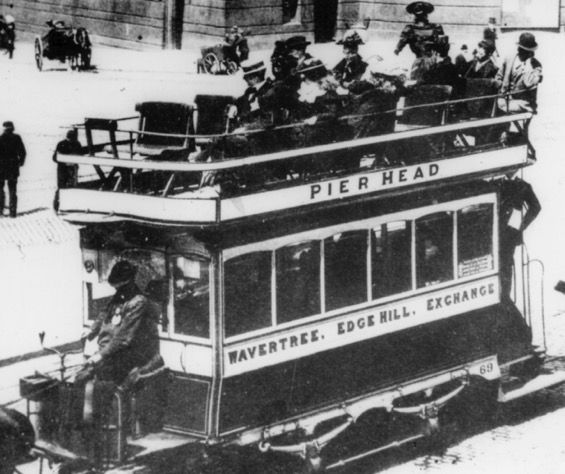
A postcard of Horsecar No 69 outside St George's Hall in Lime St — photo undated, but thought to have been taken around 1885. The driver sports a large round licence, whilst the conductor can just be glimpsed on the back platform. The lack of advertisements suggests that the vehicle, an Eades reversible patent car (designated 'Type C' by Horne & Maund), may have been brand new. Photo courtesy of the Tramways and Light Railway Society, with thanks to David Voice.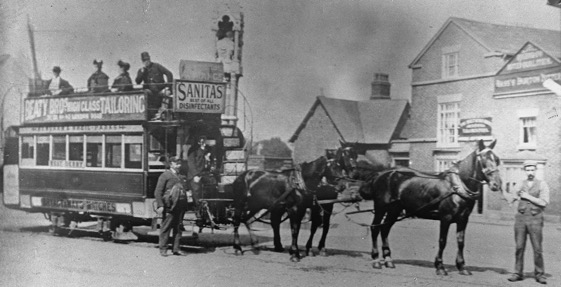
A postcard view of Horsecar No 49 in the village square at West Derby — the postcard is dated '1890s', but the photo was more than likely taken in the mid 1880s given that it depicts one of the earliest designs of tramcar ('Type B'). Photo courtesy of the Tramways and Light Railway Society, with thanks to David Voice.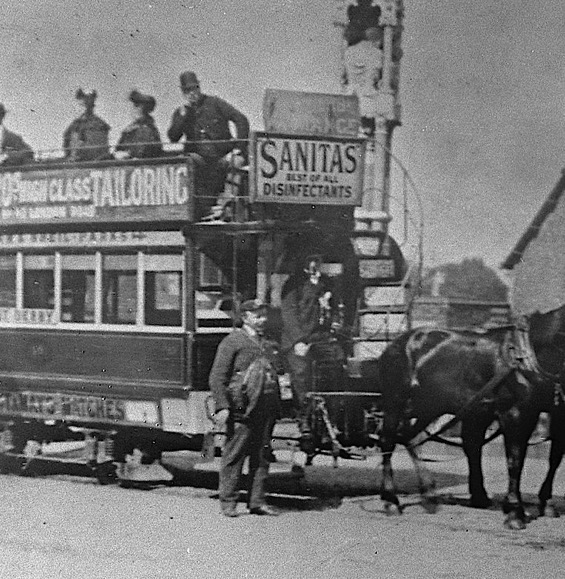
A blow-up of the above photo showing the conductor, revealing the cut-away nature of his jacket and the low profile of the cap, with its prominent cap badge. Both the crew men are wearing round municipal licences, though these are not easily discerned. 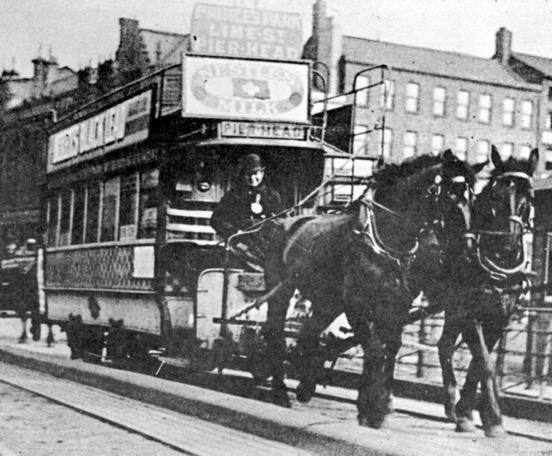
The driver of a tartan-liveried horsecar (possibly a 'Type D') guides his charge across the swing bridge over George's Dock Passage — photo undated, but probably taken in the late 1880s. The driver's large round licence has caught the light, making it easy to see its overall size and shape. Photo courtesy of the Tramways and Light Railway Society, with thanks to David Voice.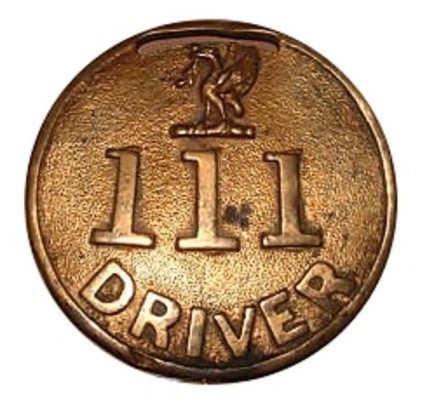
Probable Liverpool horse tram driver's licence — brass. With thanks to Stephen Howarth.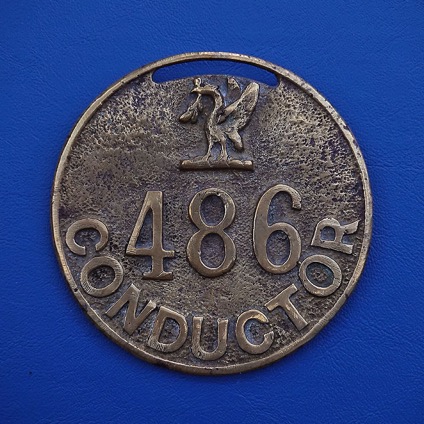
Probable Liverpool horse tram conductor's licence — brass. Photo courtesy of the Alan Robson Collection.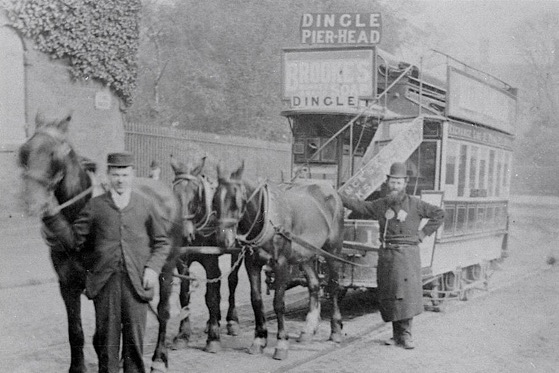
An unidentified 7-window horsecar stands at the terminus at Dingle — photo undated, but probably taken in the 1880s. The figure holding the trace horse on the left is wearing a 'pillbox' style of kepi cap; he may well be a 'trace horse' boy/man, as his cap does not have a badge, and neither does he have the standard accoutrements of a conductor, i.e., a licence and cash bag. Photo courtesy of Rob Jones.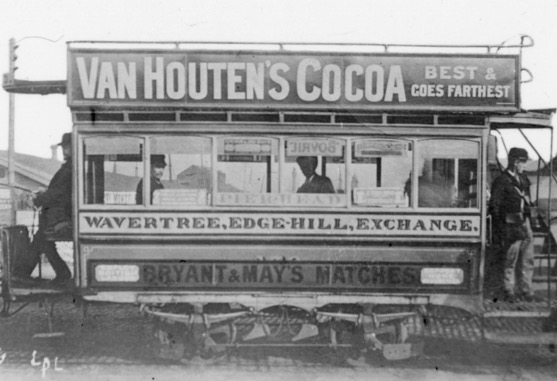
An Ashburys-built horsecar of the Eades reversible patent variety ('Type C'), laden with advertisements and working the Wavertree to Exchange route — photo undated, but probably taken in the late 1880s. The driver and conductor seem almost oblivious to the presence of the photographer, who has managed to capture the conductor side on, revealing the squat kepi-style cap and cut-away jacket. Photo courtesy of the Tramways and Light Railway Society, with thanks to David Voice.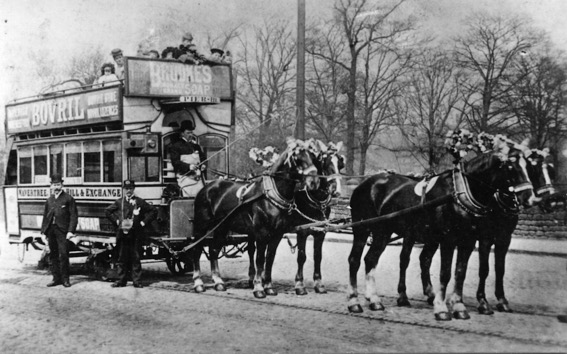
Another unidentified horsecar ('Type C'), turned out with four immaculately groomed horses on what was possibly May Day — photo undated, but probably taken in the early 1890s. Photo courtesy of the Tramways and Light Railway Society, with thanks to David Voice.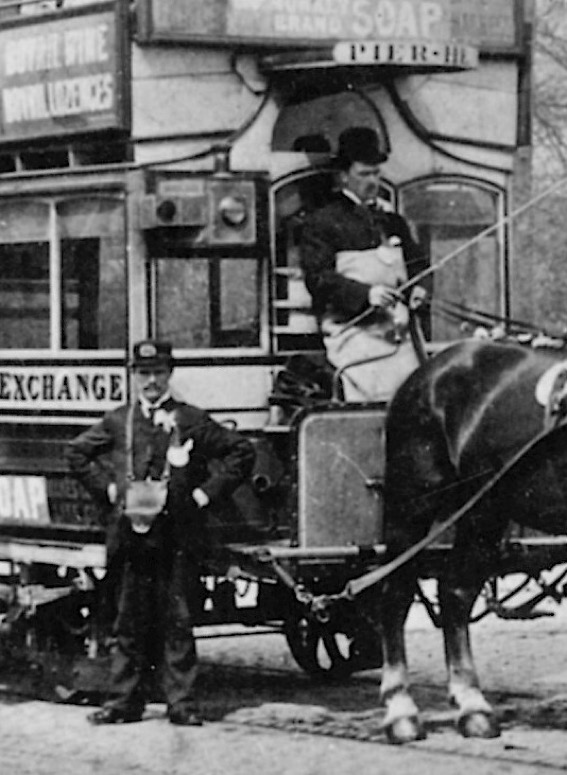
A blow-up of the above photo showing the conductor and driver, both of whom are wearing licences. The oval form of the conductor's cap badge is easily made out. 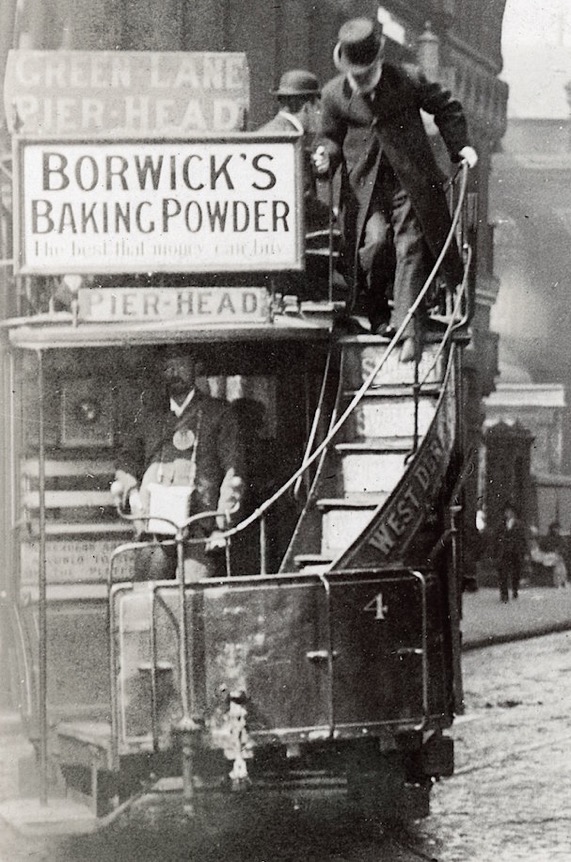
Although the conductor is heavily shaded by the canopy of his vehicle (Horsecar No 4), the photo does show very clearly the large size of the licence, which appears to be fully 6 or 7 inches across. Photo undated, but possibly taken in the early 1890s. Photograph courtesy of the Alan Brotchie Collection.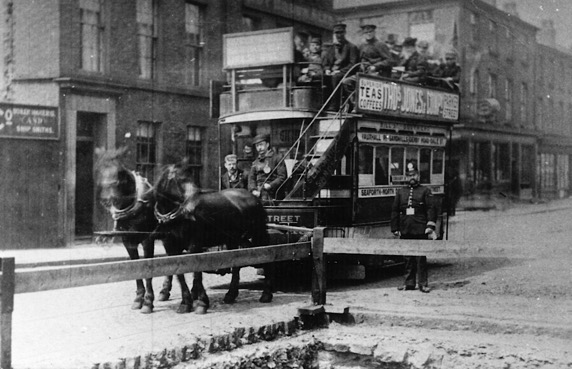
The driver of an unidentified horsecar ('Type F') — working the Seaforth Sands route — concentrates as his heavily laden vehicle passes some roadworks at Derby Bridges on the 25th May 1894. Photo courtesy of the Tramways and Light Railway Society, with thanks to David Voice.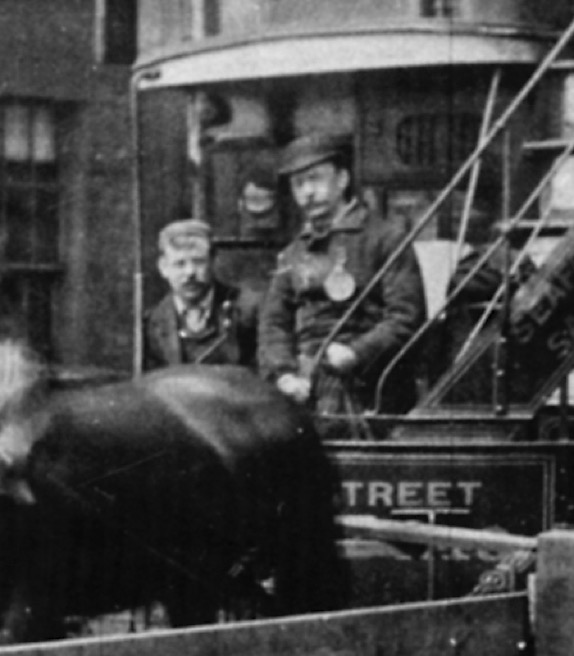
A blow-up of the above photo showing the bowler-hatted driver, again with prominent licence. 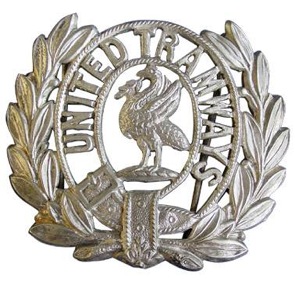
Liverpool United Tramways cap badge — white metal. The example shown here is the only one known in this material, and considering its pristine condition, it is almost certainly a manufacturer's pattern book example. With thanks to Talisman Auctions.